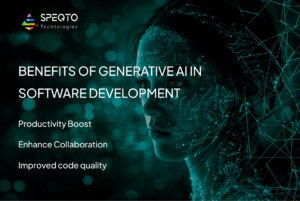
How a BDE Connects Business Vision With Technology
How a BDE Connects Business Vision With Technology Kumkum Kumari 21/11/2025At Speqto, we work with organizations that are constantly evolving entering new markets, scaling operations, or […]


Generative AI, or GenAI, is quickly becoming a game-changer in software development, helping teams build better code faster than ever before. If you’re a developer, project manager, or tech leader looking to stay ahead, this post is for you. We’ll explore how GenAI is evolving from simple helpers to powerful tools that reshape workflows. Why does it matter? In a world where deadlines are tight and innovation is key, GenAI can boost productivity by 20-50%, cut down on errors, and open up new ways to create software. As we head into 2025, ignoring this trend could mean falling behind competitors who are already leveraging it for smarter, more efficient development.
Think about the daily grind of coding—debugging, writing repetitive scripts, or refactoring old code. GenAI steps in to handle these tasks, freeing up your time for the creative stuff. It’s not about replacing developers; it’s about making their jobs easier and more impactful. With adoption rates soaring, now’s the time to understand how to integrate generative AI into your software development processes.
Software development has always been a mix of art and science, but it’s often bogged down by manual tasks that eat up hours. Traditionally, developers spend a ton of time on boilerplate code, testing, and documentation, which can lead to burnout and delays. Enter generative AI: powered by advanced models like large language models (LLMs), it generates code, suggests fixes, and even designs architectures based on natural language inputs.
The background here ties back to the rapid advances in AI over the last few years. What started as basic auto-complete features in IDEs has grown into full-fledged systems that understand context and intent. By 2025, forecasts suggest over 70% of enterprises will use GenAI in some form for development, driven by the need for faster iteration in agile environments. This shift addresses core pain points like skill gaps in teams and the pressure to deliver high-quality software amid rising complexity.
At Speqto, our approach to integrating generative AI in software development focuses on blending it seamlessly with human expertise. We start by assessing a project’s needs—whether it’s speeding up prototyping or automating QA—and then layer in GenAI tools that fit without disrupting workflows. For instance, we use prompt engineering to guide AI outputs, ensuring they align with specific requirements like security standards or tech stacks.
This method isn’t one-size-fits-all. We emphasize iterative implementation: pilot GenAI on small tasks, gather feedback, and scale up. The goal is to create a hybrid system where AI handles the heavy lifting, but developers oversee the final touches. This has helped us reduce development cycles significantly, making projects more agile and cost-effective.
Several tools stand out for generative AI in software development. GitHub Copilot is a favorite—it integrates directly into IDEs like VS Code, offering real-time code suggestions and even generating entire functions from comments. Another powerhouse is Amazon CodeWhisperer, which excels in enterprise settings by providing secure, customized recommendations.
Techniques like fine-tuning LLMs allow us to tailor models to specific domains, such as frontend development with React or backend with Node.js. We also employ Retrieval-Augmented Generation (RAG) to pull in relevant data, improving accuracy. For processes, we incorporate GenAI into CI/CD pipelines for automated testing and deployment, ensuring smooth transitions from code gen to production.
One key tip: master prompt engineering. Vague inputs lead to subpar results, so be specific—include details like language, frameworks, and constraints. We’ve learned that combining GenAI with code reviews prevents issues like hidden bugs; always have a human double-check.
Another lesson: prioritize ethics. Verify that generated code doesn’t infringe on copyrights and use tools with built-in security scans. Start small to build confidence—our teams found that experimenting on non-critical projects reduced resistance and highlighted quick wins. Finally, invest in training; understanding GenAI’s limits helps avoid over-reliance and keeps your skills sharp.
Data backs this up: a recent study shows developers using GenAI complete tasks 35-45% faster, with refactoring time dropping by 20-30%. For example, in one benchmark, teams generated documentation 45-50% quicker. At Speqto, we’ve seen real metrics too—a project that integrated GenAI cut frontend dev time by 35%, from weeks to days.
A flowchart depicting the GenAI workflow in software development, from prompt input to code generation and human review. Alt text: Generative AI workflow diagram for efficient software development.
Take our recent internal tool rebuild at Speqto. We used GenAI to modernize a legacy system, where Copilot generated initial code structures and DeepCode flagged potential issues. What could’ve taken a month was done in under two weeks, with the team focusing on custom logic instead of basics. This not only sped things up but also improved code quality, leading to fewer post-launch fixes.
For more on AI tools, check out our related posts: Exploring Top 8 Differences: AI Chat GPT vs Bard AI and Understanding the Latest Web Development Tech Stack.
Generative AI is revolutionizing software development by making it faster, smarter, and more accessible. From tackling everyday bottlenecks to enabling innovative solutions, it’s a tool every team should explore. As we look to 2025, embracing GenAI could be the edge your projects need.
Ready to dive in? Start with a free trial of GitHub Copilot or reach out to Speqto’s AI team for a consultation on integrating generative AI into your software development workflow. Let’s build something amazing together.
Have questions or need help integrating GenAI at scale? Reach out to Speqto’s AI solutions team or explore our AI services page.

How a BDE Connects Business Vision With Technology
How a BDE Connects Business Vision With Technology Kumkum Kumari 21/11/2025At Speqto, we work with organizations that are constantly evolving entering new markets, scaling operations, or […]

Apache JMeter Demystified: Your 7-Stage Blueprint for a Seamless First Performance Test
Apache JMeter Demystified: Your 7-Stage Blueprint for a Seamless First Performance Test Megha Srivastava 21 November 2025 In the intricate world of software development and deployment, ensuring a robust user experience is paramount. A slow application can quickly deter users, impacting reputation and revenue. This is where Apache JMeter emerges as an indispensable tool, offering […]

STRIDE Simplified: A Hands-On Blueprint for Pinpointing Software Threats Effectively
STRIDE Simplified: A Hands-On Blueprint for Pinpointing Software Threats Effectively Megha Srivastava 21 November 2025 In the intricate landscape of modern software development, proactive security measures are paramount. While reactive incident response is crucial, preventing vulnerabilities before they become exploits is the hallmark of robust software engineering. This is where threat modeling, and specifically the […]

From Static to Streaming: A Practical Developer’s Guide to Real-time Applications Using GraphQL Subscriptions
From Static to Streaming: A Practical Developer’s Guide to Real-time Applications Using GraphQL Subscriptions Shakir Khan 21 November 2025 The Paradigm Shift: From Static to Streaming Experiences In an era where user expectations demand instant gratification, the web has rapidly evolved beyond its static origins. Today, a modern application’s success is often measured by its […]

The TanStack Query Edge: Deep Dive into Advanced Caching for Optimal Application Speed
The TanStack Query Edge: Deep Dive into Advanced Caching for Optimal Application Speed Shubham Anand 21 November 2025 In the relentless pursuit of seamless user experiences and lightning-fast web applications, data management stands as a formidable challenge. Modern front-end frameworks demand intelligent solutions to handle asynchronous data, and this is precisely where TanStack Query (formerly […]